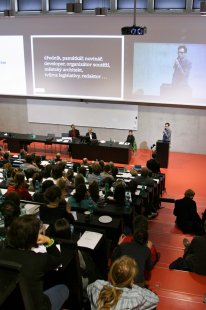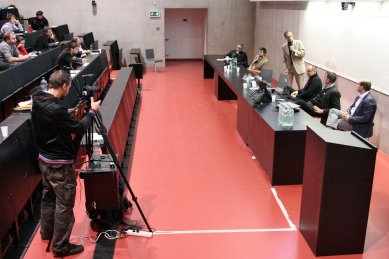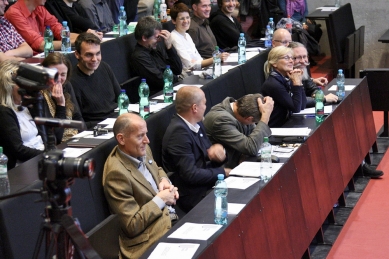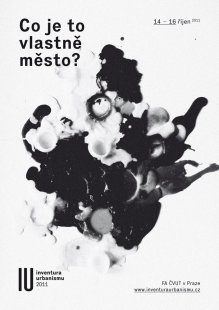
inventory of urbanism 2011 - reflection
On October 14 and 15, 2011, the second conference of INVENTORY OF URBANISM took place in Prague under the subtitle:
INVENTORY OF URBANISM is a project of intensive meetings of architects and experts involved in the creation of public space. It offers a platform for exchanging opinions and formulating positions on the creation of public space, aiming to map the state of urbanism in the Czech Republic, support theoretical reflection in the field, and communicate with the public and public administration.
The concept of the Inventory of Urbanism is composed of: Jan Jehlík, Irena Fialová, Petr Hlaváček, Roman Koucký, Radek Kolařík, Jakub Filip Novák, Jana Tichá, Michal Kohout, Jan Sedlák, Jiří Plos.
Why INVENTORY OF URBANISM?
There is increasing pressure from both laypeople and professionals dissatisfied with the quality of our landscape, cities, countryside, and individual buildings. Society finds it difficult to balance the individual and the collective, the private and the public. The process of spatial planning is incomprehensible to the public, and this dissatisfaction generates unmanaged conflicts among various groups. The revival of interest in the landscape, city, and countryside is changing the public's view on the cultural environment, which is reflected in a gradual change in life perspectives and styles. Our legislation is not prepared for these changes. Even politicians today are discovering under public pressure that transparent and high-quality investments in cities and landscapes have long-term significance and purpose.
The Inventory of Urbanism originated within the Institute of Urbanism of the Faculty of Architecture at the Czech Technical University in Prague. The main goal of the institute is to find a way back to architecture, to urbanism as designing urban environments. Urbanism has acted for several decades merely as an auxiliary discipline of spatial planning and has resigned from the common theme of architecture. This has negatively affected the creation of quality environments in terms of beautiful, useful, and solid buildings, in terms of conscious design of the physical space of settlements and landscapes.
The main theme of INVENTORY OF URBANISM 2011 was the question “What is a City, Really?” along with the guiding quote from Manuel de Solá-Morales: “Today’s urban project consists much more in the strategic and material and is characterized by
the intensity of an acupuncture intervention into the surface of the body, which will affect the organ stored in depth.” Loosely interpreted: it is clear that traditional spatial planning is unable to reflect the current needs of cities; plans must resonate much more vivaciously with the real strategies of municipalities and with the physical structure of settlements; spatial planning must be prepared to generate and absorb current projects as authentic operational tools, as initiators of qualitative transformations.
The discussions on the first day were divided into three blocks titled: A. “Who Builds the City?”, B. “For Whom Do We Build the City?”, C. “How Do We Build the City?”. Each block contained contributions from invited politicians, architects, and other experts on the specified topics. The second day continued with three thematic panels moderated discussions among speakers and participants of the conference. The first discussion panel had the theme “The Border Between City and Landscape”, the second panel had the theme “Reserves of the Center”, the third panel had the theme “Inner Peripheries – Building in the City”.
This year's edition thus focused on the main subject of urbanism: the city. It is paradoxical that the more people live in cities, the less we understand cities as organisms, and thus we are less able to build them. Uncontrolled spreading into the landscape, extensive inner peripheries, and lifeless centers are typical features of contemporary settlements. The second paradox is that although building cities is an extraordinary economic, social, and cultural force, the knowledge of this building is at the brink of political interest. The public sphere, as a representative of the state, municipalities, and citizens, is not the initiator of quality construction, does not set the bar for the private sector, and is mostly only dragged along by events. Unlike successful Western European experiences, Czech public administration rarely invites architects to collaborate on the creation of quality environments. Yet the experiences from the implementation of large urban-forming units prove that no matter how great the effort and professionalism of the involved experts, it is not possible to create a truly urban environment solely through private investments. Even the generally mentioned aggressiveness of developers is merely a consequence of the weak and uninformed activity of public administration, in worse cases a consequence of its speculations. And the third paradox is that the bureaucratic mechanism of vulgarized functionalist spatial planning is used as the main tool for the protection, transformation, and development of the city. The inherently creative work of politicians, officials, and both professional and lay public on a common agreement is replaced by anonymous, alibistic activity in a non-friendly environment over a non-friendly plan. Conference participants stated that the tools of spatial planning under current legislation are not adequate for the healthy and sustainable development of our settlements. Finding suitable tools and processes (selection of participants, responsibility, quality, efficiency, etc.) is evidently the most important common task for experts and politicians today.
Therefore, this year’s individual blocks were dedicated to both political perspectives on building cities and theoretical starting points for their planning, as well as practical examples of tools and processes (i.e., projects) leading to a successful navigation of this challenging path.
The organizers fulfilled the wish to invite participants with a wide spectrum of opinions and ages. The following list of speakers and the titles of their presentations clearly shows how broad the scope was and the paths along which this search is heading.
More Detailed Information >
Inventory of Urbanism 2011: What is a City, Really?
It was organized by the Faculty of Architecture at the Czech Technical University in Prague under the auspices of the Czech Chamber of Architects and in cooperation with the publishing house Zlatý řez. The conference was attended by 25 speakers and approximately 350 other participants. The proceedings of both days were broadcast online on the Faculty of Architecture’s website.INVENTORY OF URBANISM is a project of intensive meetings of architects and experts involved in the creation of public space. It offers a platform for exchanging opinions and formulating positions on the creation of public space, aiming to map the state of urbanism in the Czech Republic, support theoretical reflection in the field, and communicate with the public and public administration.
The concept of the Inventory of Urbanism is composed of: Jan Jehlík, Irena Fialová, Petr Hlaváček, Roman Koucký, Radek Kolařík, Jakub Filip Novák, Jana Tichá, Michal Kohout, Jan Sedlák, Jiří Plos.
Why INVENTORY OF URBANISM?
There is increasing pressure from both laypeople and professionals dissatisfied with the quality of our landscape, cities, countryside, and individual buildings. Society finds it difficult to balance the individual and the collective, the private and the public. The process of spatial planning is incomprehensible to the public, and this dissatisfaction generates unmanaged conflicts among various groups. The revival of interest in the landscape, city, and countryside is changing the public's view on the cultural environment, which is reflected in a gradual change in life perspectives and styles. Our legislation is not prepared for these changes. Even politicians today are discovering under public pressure that transparent and high-quality investments in cities and landscapes have long-term significance and purpose.
The Inventory of Urbanism originated within the Institute of Urbanism of the Faculty of Architecture at the Czech Technical University in Prague. The main goal of the institute is to find a way back to architecture, to urbanism as designing urban environments. Urbanism has acted for several decades merely as an auxiliary discipline of spatial planning and has resigned from the common theme of architecture. This has negatively affected the creation of quality environments in terms of beautiful, useful, and solid buildings, in terms of conscious design of the physical space of settlements and landscapes.
The main theme of INVENTORY OF URBANISM 2011 was the question “What is a City, Really?” along with the guiding quote from Manuel de Solá-Morales: “Today’s urban project consists much more in the strategic and material and is characterized by
the intensity of an acupuncture intervention into the surface of the body, which will affect the organ stored in depth.” Loosely interpreted: it is clear that traditional spatial planning is unable to reflect the current needs of cities; plans must resonate much more vivaciously with the real strategies of municipalities and with the physical structure of settlements; spatial planning must be prepared to generate and absorb current projects as authentic operational tools, as initiators of qualitative transformations.
The discussions on the first day were divided into three blocks titled: A. “Who Builds the City?”, B. “For Whom Do We Build the City?”, C. “How Do We Build the City?”. Each block contained contributions from invited politicians, architects, and other experts on the specified topics. The second day continued with three thematic panels moderated discussions among speakers and participants of the conference. The first discussion panel had the theme “The Border Between City and Landscape”, the second panel had the theme “Reserves of the Center”, the third panel had the theme “Inner Peripheries – Building in the City”.
This year's edition thus focused on the main subject of urbanism: the city. It is paradoxical that the more people live in cities, the less we understand cities as organisms, and thus we are less able to build them. Uncontrolled spreading into the landscape, extensive inner peripheries, and lifeless centers are typical features of contemporary settlements. The second paradox is that although building cities is an extraordinary economic, social, and cultural force, the knowledge of this building is at the brink of political interest. The public sphere, as a representative of the state, municipalities, and citizens, is not the initiator of quality construction, does not set the bar for the private sector, and is mostly only dragged along by events. Unlike successful Western European experiences, Czech public administration rarely invites architects to collaborate on the creation of quality environments. Yet the experiences from the implementation of large urban-forming units prove that no matter how great the effort and professionalism of the involved experts, it is not possible to create a truly urban environment solely through private investments. Even the generally mentioned aggressiveness of developers is merely a consequence of the weak and uninformed activity of public administration, in worse cases a consequence of its speculations. And the third paradox is that the bureaucratic mechanism of vulgarized functionalist spatial planning is used as the main tool for the protection, transformation, and development of the city. The inherently creative work of politicians, officials, and both professional and lay public on a common agreement is replaced by anonymous, alibistic activity in a non-friendly environment over a non-friendly plan. Conference participants stated that the tools of spatial planning under current legislation are not adequate for the healthy and sustainable development of our settlements. Finding suitable tools and processes (selection of participants, responsibility, quality, efficiency, etc.) is evidently the most important common task for experts and politicians today.
Therefore, this year’s individual blocks were dedicated to both political perspectives on building cities and theoretical starting points for their planning, as well as practical examples of tools and processes (i.e., projects) leading to a successful navigation of this challenging path.
The organizers fulfilled the wish to invite participants with a wide spectrum of opinions and ages. The following list of speakers and the titles of their presentations clearly shows how broad the scope was and the paths along which this search is heading.
More Detailed Information >
The English translation is powered by AI tool. Switch to Czech to view the original text source.





0 comments
add comment
Related articles
0
31.10.2021 | Urbanism Inventory 2021
0
26.11.2018 | Urbanism Inventory 2018 - Invitation to the 9th Annual Conference
0
24.11.2017 | Inventory of Urbanism 2017 - Invitation to the 8th Annual Conference
0
09.11.2016 | Urbanism Inventory 2016 - Invitation to the 7th Annual Conference
0
27.11.2015 | Inventory of Urbanism 2015 - How to Teach Architects about the Countryside?
0
03.12.2014 | Inventory of Urbanism 2014 - Reflection
0
20.10.2011 | The performance of the Atelier Liberec at the Urbanism Inventory 2011
0
19.10.2011 | Irena Fialová : URBAN PROJECT - CITY PROJECT
0
19.10.2011 | Jan Jehlík : HMOTA - SPACE - EVENTS
0
27.01.2011 | Inventory of Urbanism (II.)
4
10.10.2010 | In Prague, a platform called Urbanism Inventory has been created
0
11.09.2010 | inventory of urbanism 2010










